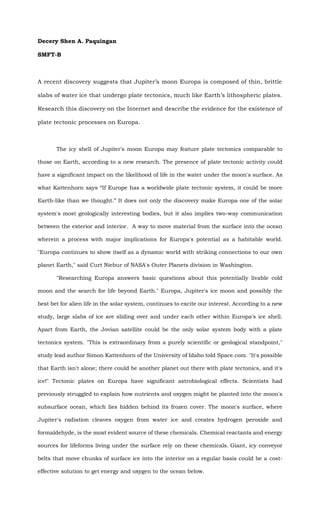Active Learning Exercise 2 Plate Tectonics and the Ocean Floor.docx
- 1. Decery Shen A. Paquingan SMFT-B A recent discovery suggests that Jupiter’s moon Europa is composed of thin, brittle slabs of water ice that undergo plate tectonics, much like Earth’s lithospheric plates. Research this discovery on the Internet and describe the evidence for the existence of plate tectonic processes on Europa. The icy shell of Jupiter's moon Europa may feature plate tectonics comparable to those on Earth, according to a new research. The presence of plate tectonic activity could have a significant impact on the likelihood of life in the water under the moon's surface. As what Kattenhorn says “If Europe has a worldwide plate tectonic system, it could be more Earth-like than we thought.” It does not only the discovery make Europa one of the solar system's most geologically interesting bodies, but it also implies two-way communication between the exterior and interior. A way to move material from the surface into the ocean wherein a process with major implications for Europa's potential as a habitable world. "Europa continues to show itself as a dynamic world with striking connections to our own planet Earth," said Curt Niebur of NASA's Outer Planets division in Washington. "Researching Europa answers basic questions about this potentially livable cold moon and the search for life beyond Earth." Europa, Jupiter's ice moon and possibly the best bet for alien life in the solar system, continues to excite our interest. According to a new study, large slabs of ice are sliding over and under each other within Europa's ice shell. Apart from Earth, the Jovian satellite could be the only solar system body with a plate tectonics system. "This is extraordinary from a purely scientific or geological standpoint," study lead author Simon Kattenhorn of the University of Idaho told Space.com. "It's possible that Earth isn't alone; there could be another planet out there with plate tectonics, and it's ice!" Tectonic plates on Europa have significant astrobiological effects. Scientists had previously struggled to explain how nutrients and oxygen might be planted into the moon's subsurface ocean, which lies hidden behind its frozen cover. The moon's surface, where Jupiter's radiation cleaves oxygen from water ice and creates hydrogen peroxide and formaldehyde, is the most evident source of these chemicals. Chemical reactants and energy sources for lifeforms living under the surface rely on these chemicals. Giant, icy conveyor belts that move chunks of surface ice into the interior on a regular basis could be a cost- effective solution to get energy and oxygen to the ocean below.

